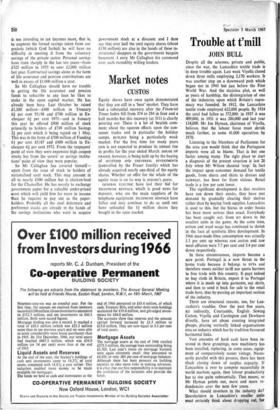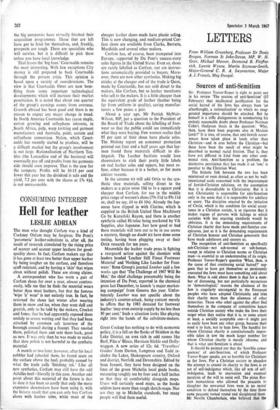Trouble at t'mill
JOHN BULL
Despite all the schemes, private and public, since the war, the Lancashire textile trade is 'in deep trouble again. Last week Viyella closed down three mills employing 2,170 workers. It was another step on a downward path which began not in 1945 but just before the First World War. And the statistics plot, as well as years of hardship, the disintegration of one of the industries upon which Britain's supre- macy was founded. In 1912, the Lancashire textile trade employed 622,000 people. By 1924 the total had fallen to 572,000; in 1937 it was 409,000, in 1951 it was 286,000 and last year 114,000. Mr Joe Hyman, chairman of Viyella, believes that the labour force must shrink much further, to some 41,000 operatives by 1970.
Listening to the Members of Parliament for the area you would think that the Portuguese imports were all to blame. That is but one factor among many. The right place to start a diagnosis of the present situation is last 20 July when Mr Wilson shouted 'stop.' In fact the impact upon consumer demand for textile goods, from sheets and shirts to dresses and rainwear, has been far from vicious. Retail trade is a few per cent lower.
The significant development is that retailers have run down their stocks, they have met demand by gradually clearing their shelves rather than by buying fresh supplies. Lancashire is used to this, but the hiatus in order books has been more serious than usual. Everybody has been caught out, from ict down to the smallest units in the game. At the same time, cotton and wool usage has continued to shrink in the face of synthetic fibre development. In 1966 man-made fibre consumption was actually 1.5 per cent up whereas raw cotton and raw wool offtakes were 7.7 per cent and 3.4 per cent down respectively.
In these circumstances, imports become a sore point. Portugal is a new threat to the home trade because it belongs to EFTA and therefore meets neither tariff nor quota barriers to free trade with this country. It pays indeed to buy cloth in Britain, export it to Portugal where it is made up into garments, say shirts, and then to send it back for sale to the retail trade here, thus by-passing an important section of the industry.
There are structural reasons, too, for Lan- cashire's troubles. Over the past five years, ict indirectly, Courtaulds, English Sewing Cotton, Viyella and Carrington and Dewhurst directly, have set about creating integrated gt'oups, placing vertically linked organisations into an industry which has by tradition favoured horizontal links.
Vast amounts of bard cash have been in- vested in these groupings, new machinery has been installed, replacing, in some cases, equip- ment of comparatively recent vintage. Neces- sarily parallel with this process, there has been Much closing down of surplus capacity. If Lancashire is ever to compete successfully in world markets again, then labour productivity has to rise quite substantially. That means, as Mr Hyman points out, more and more re- dundancies over the next few years.
What should investors in the industry do? Shareholders in Lancashire's smaller units must certainly think about dropping out, for
the big companies have virtually finished their acquisition programmes. Those that are left have got to fend for themselves, and, frankly, prospects are tough. There are specialists who will survive, but it is difficult to pick these unless you have local knowledge.
That leaves the 'big four.' Courtaulds remains the most interesting. With few exceptions City money is still prepared to back Courtaulds through the present crisis. This opinion is based upon a variety of considerations. The view is that Courtaulds fibres are now bene- fiting from some important technological developments which will increase their market penetration. It is noted that about one quarter of the group's earnings comes from overseas. Growth abroad has been good and there is no reason to expect any major change in trend. In North America Courtaulds has rayon staple, cotton growing and cellophane interests, in South Africa, pulp, warp knitting and garment manufacture and Australia, paint, acetate and cellophane conversion. Nylon, which Court- aulds has recently started to produce, will be a difficult market but the group's involvement is not large. Rationalisation of Northern Tex- tiles (the Lancashire end of the business) will eventually pay off and profits from the garments side should soon improve. That is the case for the company. Profits will be 10-15 per cent lower this year but the dividend is safe and the yield, 7.2 per cent with the shares at 17s 4}d, is not unreasonable.



































 Previous page
Previous page